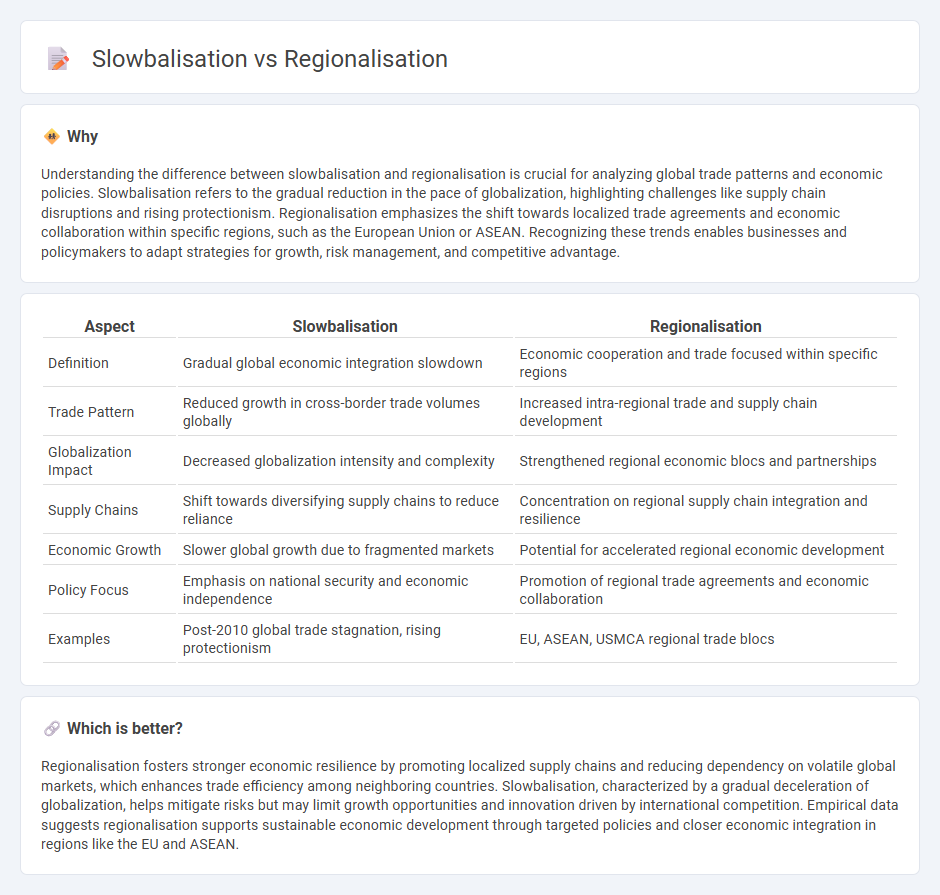
The shift from globalisation towards slowbalisation reflects a deceleration in worldwide trade and investment flows, driven by geopolitical tensions and supply chain reconfigurations. Regionalisation gains momentum as economies prioritise local markets and intra-regional partnerships to enhance resilience and reduce dependency on distant suppliers. Discover how these dynamics reshape global economic strategies and impact future growth opportunities.
Why it is important
Understanding the difference between slowbalisation and regionalisation is crucial for analyzing global trade patterns and economic policies. Slowbalisation refers to the gradual reduction in the pace of globalization, highlighting challenges like supply chain disruptions and rising protectionism. Regionalisation emphasizes the shift towards localized trade agreements and economic collaboration within specific regions, such as the European Union or ASEAN. Recognizing these trends enables businesses and policymakers to adapt strategies for growth, risk management, and competitive advantage.
Comparison Table
| Aspect | Slowbalisation | Regionalisation |
|---|---|---|
| Definition | Gradual global economic integration slowdown | Economic cooperation and trade focused within specific regions |
| Trade Pattern | Reduced growth in cross-border trade volumes globally | Increased intra-regional trade and supply chain development |
| Globalization Impact | Decreased globalization intensity and complexity | Strengthened regional economic blocs and partnerships |
| Supply Chains | Shift towards diversifying supply chains to reduce reliance | Concentration on regional supply chain integration and resilience |
| Economic Growth | Slower global growth due to fragmented markets | Potential for accelerated regional economic development |
| Policy Focus | Emphasis on national security and economic independence | Promotion of regional trade agreements and economic collaboration |
| Examples | Post-2010 global trade stagnation, rising protectionism | EU, ASEAN, USMCA regional trade blocs |
Which is better?
Regionalisation fosters stronger economic resilience by promoting localized supply chains and reducing dependency on volatile global markets, which enhances trade efficiency among neighboring countries. Slowbalisation, characterized by a gradual deceleration of globalization, helps mitigate risks but may limit growth opportunities and innovation driven by international competition. Empirical data suggests regionalisation supports sustainable economic development through targeted policies and closer economic integration in regions like the EU and ASEAN.
Connection
Slowbalisation and regionalisation are interconnected as slowbalisation, the gradual deceleration of global economic integration, prompts countries to focus on strengthening regional trade agreements and supply chains. Regionalisation enhances economic resilience by reducing dependence on distant global markets and fostering localized production and consumption networks. This shift supports more sustainable growth patterns by balancing global connectivity with regional economic stability.
Key Terms
Trade Networks
Regionalisation strengthens trade networks by promoting closer economic ties within specific geographic areas, enhancing supply chain resilience and reducing dependency on distant markets. Slowbalisation reflects a gradual deceleration of globalization, where cross-border trade growth slows due to rising protectionism and geopolitical tensions, leading to more localized and diversified trade patterns. Discover how these contrasting trends reshape global commerce and influence future trade strategies.
Supply Chains
Regionalisation narrows supply chains by localizing production and sourcing within specific geographic areas, enhancing resilience against global disruptions. In contrast, slowbalisation reflects a deliberate deceleration of global supply chain integration, balancing efficiency with risk mitigation by diversifying and shortening supplier networks. Explore how these trends reshape global logistics and manufacturing strategies.
Tariffs
Regionalisation involves forming trade blocs with preferential tariffs that reduce barriers within specific geographic areas, boosting intra-regional commerce. Slowbalisation reflects a gradual decline in global trade growth, often prompting countries to impose higher tariffs to protect domestic industries. Explore how shifting tariff policies influence global and regional trade dynamics.
Source and External Links
Regionalisation - Congress of Local and Regional Authorities - Regionalisation is the process of transferring power from the central government to regions to better apply subsidiarity, including establishing and empowering regional authorities with competences and financial autonomy within national or federal frameworks.
Regionalisation - Wikipedia - Regionalisation in politics means dividing a country into smaller jurisdictions and transferring power to those regions, reflecting a tendency to form decentralized regions, opposite to unitarisation.
Can economic regionalism bring more success than globalisation? - Economic regionalisation has boosted competitiveness and manufacturing, affecting supply chains and global logistics by potentially shifting production due to geopolitical and policy factors, but not ending international supply chains.
 dowidth.com
dowidth.com